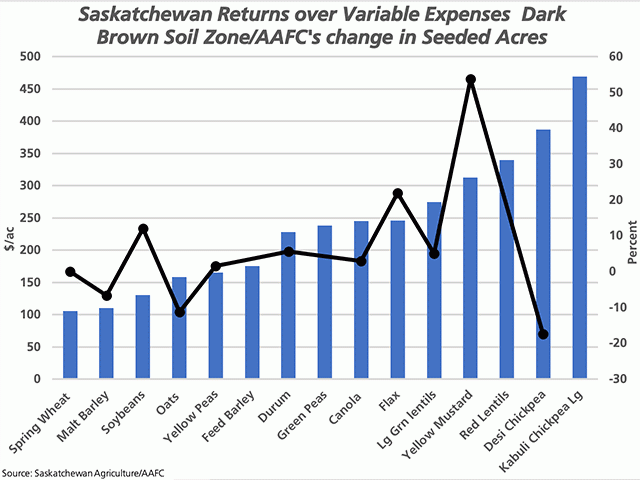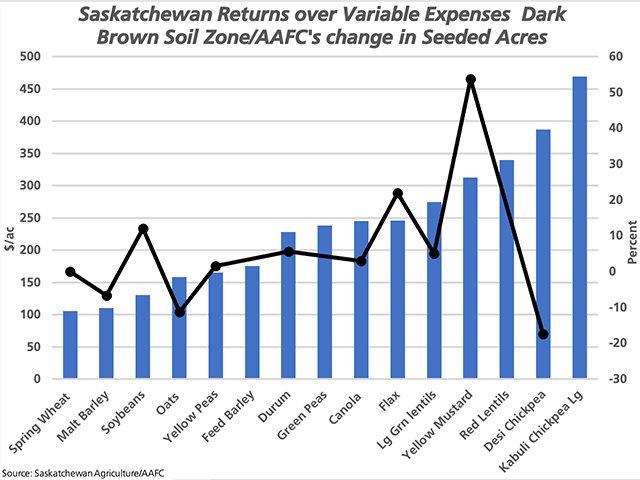Canada Markets
Governments Release Forecasts for 2021
The blue bars on the attached chart represent the forecast returns for select Saskatchewan crops over and above variable expenses across the dark brown soil zone, while plotted from lowest to highest. As expected, this report is a snapshot in time that includes a long list of assumptions.
For example, the target crop yield is based on the five-year average of the 80th percentile of production for the soil zone. Crop prices are based on reports from Agriculture and Agri-Food Canada, as well as from grain buyers, although the January release of this report will have missed the significant run-up in futures seen in recent weeks. For example, the farm gate price for canola was pegged at $11.25/bushel (bu), which is relatively close to the average of pdqinfo.ca's four regions of the province on Jan. 26 that is calculated at $11.63/bu for the month of October.
It is interesting to note that the estimated spring wheat return is $105.41/acre, the lowest of the selected crops. The estimated farm gate price is shown at $6.04/bu, while the average of pdqinfo.ca's four regions of Saskatchewan on Jan. 26 for No. 1 CWRS 13.5% was $7.10/bu. This week, AAFC released its first forecasts for 2020-21 indicating an average producer price of $6.20/bu for wheat (excluding durum).
Returns shown by the provincial government on the high end of the range of selected crops are dominated by the pulses and special crops, with yellow mustard at $312.27/mt, red lentils at $340.07/mt and large kabuli chickpeas at $469.15/mt.
Agriculture and Agri-Food Canada's January Canada: Outlook for Principal Field Crops includes a first look at seeded acres for 2021-22 at a national level. This forecast includes a 1% increase in the area planted to major grains and oilseeds at 68.6 million acres and a 3.1% increase in pulse and special crop acres to 10.2 million acres. Overall, seeded acres of all principal field crops are to increase by 1.3%, to 78.8 million acres, while 1.8% above the five-year average. For 2020, Statistics Canada reports 1.7259 million acres of summer fallow, up from the 1.702 million acres low reported for the year prior, which makes the 2021 expansion possible.
P[L1] D[0x0] M[300x250] OOP[F] ADUNIT[] T[]
The black line with markers, measured against the percent scale on the secondary vertical axis plots the year-over-year change in forecast seeded acres, by crop. The point plotted for spring wheat represents the year-over-year percent change in all wheat acres (excluding durum). The same can be said for malt barley, mustard, peas, lentils, and chickpeas, with the point plotted equal to the national change in forecast acres from 2020 to 2021 for all classes and varieties.
Of interest on this chart is a 0.1% increase in wheat acres (excluding durum). While U.S. commentary is pointing to spring wheat having to compete with row crop acres in the northern states, this data would indicate a wide variety of prairie crops that show a higher potential return than wheat. Durum acres are forecast to rise by 5.6%, while AAFC forecasts are pointing to lower available supplies of both wheat and durum in the 2020-21 crop year.
Canadian oilseed acres are forecast to grow larger in 2021-22, with canola acres forecast up 2.9%, soybeans up 12.1% and flax up 22%. Despite this increase, ending stocks of both canola and soybeans are forecast to fall in 2021-22, although uncertainty remains high over ending stocks for the current crop year, which ends in just over six months.
The largest percentage move year-over-year is seen for yellow, brown, and oriental mustard, forecast to rise by 53.8%, to 160,000 acres, or equal to the area seeded in 2019.
According to government data, the largest year-over-year contraction is seen for chickpea acres, forecast to fall by 17.4% year-over-year to 247,100 acres. This is despite Saskatchewan government data showing the largest dollar/acre return over variable costs. Current forecasts show stocks forecast to grow to 169% of use in 2020-21, while 2021-22 stocks are forecast to rise modestly although the stocks/use ratio is forecast to fall slightly to 157%.
**
DTN 360 Poll
This week's poll asks what you think of the change in the U.S. administrations. You can weigh in with your thoughts on this poll located on the lower-right side of your DTN Home Page.
Cliff Jamieson can be reached at cliff.jamieson@dtn.com
Follow him on Twitter @CliffJamieson
(c) Copyright 2021 DTN, LLC. All rights reserved.





Comments
To comment, please Log In or Join our Community .